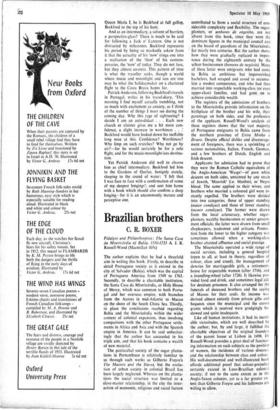Brazilian brothers
C. R. BOXER
The author explains that he had a threefold aim in writing this book. Firstly, to describe in detail Portuguese society as it existed in the city of Salvador (Bahia), which was the capital of Portuguese America from 1549 to 1763. Secondly, to describe a charitable institution, the Santa Casa da Misericordia, or Holy House of Mercy, which was common to both Portu- gal and her overseas empire, with branches from the Azores in mid-Atlantic to Macao on the shore of the South China -Sea. Thirdly, to place the conclusions reached regarding Bahia and the Misericdrdia within the wider context of colonial expansion, thus involving comparisons with the other Portuguese settle- ments in Africa and Asia and with the Spanish empire in America. It can be said unhesitat- ingly that the author has succeeded in his triple aim, and that his book contains a wealth of new material.
The patriarchal society of the sugar planta- tions in Pernambuco is relatively familiar to us through such works as Gilberto Freyre's The Masters and the Slaves, but the evolu- tion of urban society in colonial Brazil has been largely neglected. Whereas on the planta- tions the social structure was limited to a slave-master relationship, in the city the inter- action of economic, religious and racial factors contributed to form a social structure of con- siderable complexity and flexibility. The sugar- planters, or senhores de engenho, are not absent from this book, since they were the dominant figures in the municipal council and on the board of guardians of the Misericdrdia for nearly two centuries. But the author shows how they were gradually replaced in impor- tance during the eighteenth century by the urban businessmen (homens de negocio). Many of these latter were emigrants who had come to Bahia as ambitious but impoverished bachelors, had scraped and saved to accumu- late a modest competence, and who had then married into respectable working-class (or even upper-class) families, and had gon-c_ on to achieve considerable wealth.
The registers of the. admissions of brothers to the Misericdrdia provide information on the birthplace of the brother and his wife, their parentage on both sides, and the profession of the applicant. Russell-Wood's• analysis of these registers shows that the vast majority of Portuguese emigrants to Bahia came from the northern province of Entre Minho e Douro. Despite official dislike and discourage- ment of foreigners, there was a sprinkling of various nationalities, Italian, French, German, and a few brothers of Dutch, English and Irish descent.
Applicants for admission had to prove that they were the Roman Catholic equivalents of the Anglo-American Wasps'—of pure white descent on both sides, untainted by any strain of Jewish, 'Moorish' (i.e. Muslim), or Negro blood. The same applied to their wives; and brothers who married a coloured girl were in- stantly expelled. The brothers were divided into two categories, those of upper standing (major condicao) and those of lower standing (menor condicao). The former were drawn from the local aristocracy, whether sugar- planters, wealthy businessmen or senior govern- ment officials; the latter were drawn from small shopkeepers, tradesmen and artisans. Promo- tion from the lower to the higher category was sometimes allowed when a working-class brother attained affluence and social prestige.
The Misericdrdia operated a wide range of social services, including a general hospital (open to all, at least in theory, regardless of colour, class and creed), the management of dowries for marriageable girls, a retirement- house for respectable women (after 1716), and a foundling-wheel (after 1726). It likewise pro- vided food and drink, and sometimes legal aid, for destitute-prisoners. It also arranged for the funerals of deceased brothers and the saying of Masses for their souls. Its income was derived almost entirely from private gifts and bequests since the municipal and the crown grants which it received were grudgingly be- stowed and quite inadequate.
Like all human institutions, it had its inevit- able vicissitudes, which are well described by the author; but, by and large, it fulfilled the charitable objectives of the original founders of the parent house at Lisbon in 1498. Dr Russell-Wood provides a great deal of fascinat- ing information on such subjects as the position of women, the incidence of various disease'. and the relationship between class and colour. His well-documented and well-illustrated book affords additional proof that colour-prejudice certainly existed in Luso-Brazilian colonial society; if not to the same extent as in the Anglo-Saxon colonies, yet to a far greater ex- tent than Gilberto Freyre and his followers are willing to allow.






































 Previous page
Previous page